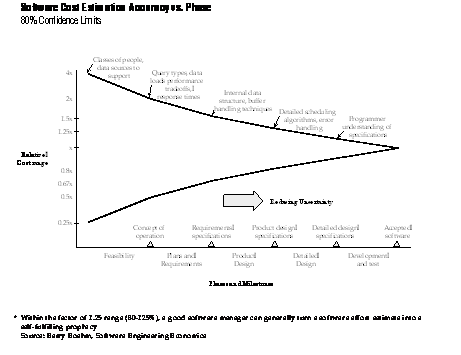I have recently been reading “Plundering the Public Sector” by David Craig and Richard Brooks, and now halfway through have been getting more and more irritated with the adversarial tone of the book, and its tendency to shower blame everywhere in unequal amounts.
UK Public Sector projects are usually particularly large (Connecting for Health is quoted as being the largest civilian IT project ever), and inevitably have all the challenges you might expect, and more of them after that.
When discussing the risk profile of projects, I usually use a 2D chart that expresses the two primary dimensions of Work Complexity and Business/Organisational Complexity, a framework drawn from my experience of programme management in large organisations.
The usual chart looks like this:
The Work Complexity dimension registers risks like complex technology, logistical scale, dynamic market environment, whereas the Organisation/Business risk dimension registers such factors as poor communication across fragmented, stove-piped structures and populations, divided loyalties, parochial viewpoints and so on, that arise in any large organisation (driven in the main by human nature in all its forms).
However, for monster public sector projects, I would recast it like this:
The black area represents the terra incognita where overall risk is extermely high due to the sheer size and people complexity, and other factors which have rarely been experienced before.
Blame-shifting and adversarial attitude are not helpful in the context of programme management, especially when exercised with 20:20 hindsight.
However, agile development methods show the way things can be if they are done right. These methods are rooted in the early insights of people like Barry Boehm, a god of software engineering who brought us this…
and this…
Iterative risk managemnt approach embedded methods can also be applied to business projects as well as pure development.
Maybe the book will get better and more evenly balanced as I read further, and maybe even propose some solutions, but, for now, having incurred my ire, it has been relegated to the bottom of the pile in the throne room where




The Public Services Industry Review, announced by Business Secretary John Hutton in December 2007, is led by DeAnne Julius, chair of the Chatham House think-tank and a non-executive director of BP and Roche.
It will examine the private and third sectors’ role in delivering public services, and how the market can be made to work more effectively.
The review marks the first time the government has acknowledged the emergence of a public services industry and attempted to define it. The deadline for submissions was April 4.
The CBI took a different view. Tom Moran, a principal policy adviser on public services, told PF: ‘One of the things we’ve called for, for a long time, was that there should be an industry unit within Berr for the public services industry in much the same way there is for manufacturing, finance etc.’
The review, in part, stems from CBI lobbying. CBI-commissioned research revealed the public services industry employs 700,000 people and generates £25bn in added value to the economy.
The review has also been told that the public sector is paying well above the market rate for some of its contracts. A submission from Compass management consultants, seen by PF, reveals that one government agency is paying 65% above the market rate for computer servers.
David Locke, Compass’s head of public sector, said: ‘We feel quite strongly that the overall governance and management structures of the contract need sharpening and tightening up. I’m hoping that the review will spend some time focusing on this.’